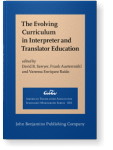Doctoral training in Translation Studies
Challenges and opportunities
The international community of translation scholars recognizes that doctoral programs are one of the main means by which it reproduces itself, affirming and developing its academic identity. The growth of translation studies during the last three decades has therefore been accompanied by a growth in doctoral programs worldwide. Nevertheless, these programs suffer from both internal and external weaknesses. This chapter will present the state of the art in doctoral training, identify new competences which have emerged as a result of new work environments, and reflect on new challenges and opportunities for training programs. Among the opportunities are closer international collaboration in the form of doctoral training networks as well as joint training with the industry.
Article outline
- Introduction
- State of the art and suggestions
- A new challenging work environment
- Virtualization of shared tools
- Translations by the users
- New challenging competences
- Material to be translated
- New skills
- Research competence of a doctorate in Translation Studies
- Basic Skills
- Research skills and techniques
- Specific TS Research Skills
- Opportunities
-
Notes
-
References
References (25)
References
Angelelli, C., & Baer, B. J. (Eds.). (2015). Researching translation and interpreting. London/New York: Routledge. 

Bologna Working Group. (2005). A framework for qualifications of the European higher education area: Bologna Working Group report on qualifications frameworks. Copenhagen: Danish Ministry of Science, Technology and Innovation. Retrieved from [URL]
Daytar, V. (2017). Dictionary of research methodologies in translation and interpreting studies. Tabriz: Zaban Academic Publishing.
Dublin descriptors. (2004). Shared ‘Dublin’ descriptors for short cycle, first cycle, second cycle and third cycle awards: A report from a Joint Quality Initiative informal group. 18 October 2004. Retrieved from [URL]
DYLAN. (2006–2011). Language dynamics and management of diversity. Retrieved from [URL]
ELISE. (2001). European language and international strategy development in SMEs: European overview report. European Overview Report. Retrieved from [URL]
European Commission. (2009). Study on the size of the language industry in the EU.
European Master’s in Translation. (2009). Competences for professional translators. Retrieved from [URL]
Hale, S., & Napier, J. (2013). Research methods in interpreting: A practical resource. London: Bloomsbury.
Kaindl, K. (2013). Multimodality and translation. In C. Millán & F. Bartrina (Eds.), The Routledge handbook of translation studies (pp. 257–270). London/New York:Routledge.
Lambert, J., Steyaert, C., & Janssens, M. (2004). Developing language strategies for international companies. Journal of International Business, 39, 414–430.
LERU. (2014). Good practice elements in doctoral training (Advice paper No. 15). Retrieved from [URL]
Mason, I. (2009). Research training in translation studies. The Interpreter and Translator Trainer, 9, 1–12. Special issue edited by I. Mason. 

Melby, A. (1993). La typologie des textes: Son importance pour la traduction automatique [The typology of texts: Its importance for machine translation]. In P. Bouillon & A. Clas (Eds.), La traductique [Translation technology] (pp. 35–40). Montréal: PUM.
Mellenger, C., & Hanson, T. (Eds.). (2017). Quantitative research methods in translation and interpreting studies. London/New York: Routledge.
Meng, J. (2015). Empirical translation studies: Interdisciplinary methodologies explored. Sheffield: Equinox Publishing.
PIMLICO. (2011). Report on language management strategies and best practice in European SMEs: The PIMLICO project. Retrieved from [URL]
Pym, A. (2012). Democratizing translation technologies: The role of humanistic research. In V. Cannavina & A. Fellet (Eds.), Language and translation automation conference (pp. 12–94). Rome: The Big Wave.
Pym, A., González Núñez, G., Miquel-Iriarte, M., Ramos Pinto, S., Teixeira, C. S. C., & Tesseur, W. (2014). Work placements in doctoral research training in the humanities: Eight cases from translation studies. Across Languages and Cultures, 15, 1–23. 

Saldanha, G., & O’Brien, S. (2014). Research methodologies in translation studies. London/New York: Routledge. 

Williams, J., & Chesterman, A. (2002). The map: A beginner’s guide to doing research in translation studies. Manchester: St Jerome.
Cited by (1)
Cited by one other publication
Dolmaya, Julie McDonough
2022.
Translator Associations and Networks. In
The Cambridge Handbook of Translation,
► pp. 198 ff.

This list is based on CrossRef data as of 29 july 2024. Please note that it may not be complete. Sources presented here have been supplied by the respective publishers.
Any errors therein should be reported to them.
